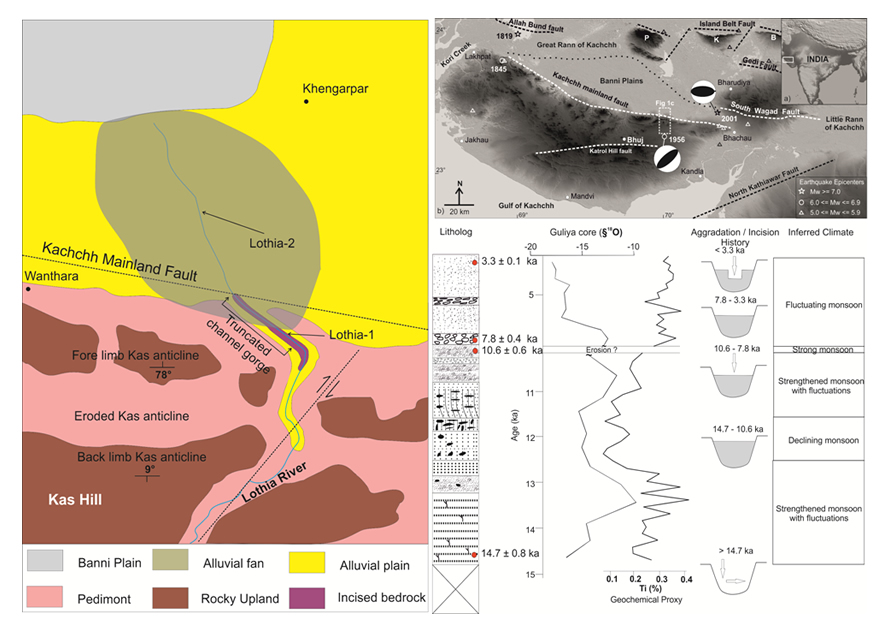Detailed geophysical and geological investigations to identify copper lead and zinc mineralization around Ambaji, Banaskantha district are in progress.

 Skip To Main Content
Skip To Main Content
Fluvial terrace formation is often regulated by external forcings like climate, tectonic and eustatic changes. These terraces, particularly in a dryland environment, preserves the discrete signatures of the external forcings, thus enabling us to reconstruct the fluvial response to the late Quaternary palaeo environmental changes and factors governing them. The present study focuses on reconstructing the aggradation/incision phases in the Lotia River which is located in the eastern segment of the Northern HillRange (NHR) of the Kachchh Peninsula. The Lotiariver drains through Mesozoic rocks before cutting across the Kachchh Mainland Fault (KMF) and finally debouch in the Banni Plains. Reconstruction based on tectonic geomorphology, sedimentology, sediment geochemistry, mineral magnetic, and OSL chronologysuggests the fluvial response to monsoon variability archived during the last 15 ka. The time framewas also marked by incision enhanced by uplift along the KMF, which led to strath terrace formation. Theaccommodation space thus created was filled by an aggradational event between 14.8 ka and 10.6 ka.Sedimentological and geochemical parameters have also suggested that the time period between12.5 ka and 11.5 ka showed a decline in the monsoon strength, which coincides with ‘Younger Dryas’.It has been observed that the sediments spanning between 10.6 ka and 7.8 ka are absent from the archive,which is most likely the manifestation of the early Holocene optimum that led to severe erosional processes.The period between 7.8 ka and 3.3 ka is marked as another aggradational phase with fluctuatingclimatic conditions. At 3.3 ka, the region has experienced an incision of 4 m, which led to the formation ofHolocene terrace T1, most likely due to tectonic uplift. During the last 3.3 ka, another pulsative uplift hasoccurred, which led to the formation of unpaired Holocene terrace T2, along with tilting of the Lotia basin.Based on the OSL chronology of bedrock strath terrace, we reported a minimum uplift rate of 1.04 mm/afor the eastern KMF during the Late Pleistocene–Holocene period, hinting seismically active nature of theKMF during this period. The terrace formation in the eastern Northern Hill Range is mostly regulated bytectonic uplifts along the KMF.

Geomorphic map of Lotia River and aggradational / incision histories
Prizomwala S.P., A. Das, G. Chauhan, T. Solanki, N. Basavaiah, Nilesh Bhatt, M.G. Thakkar and B. K. Rastogi (2016) Late Pleistocene-Holocene terrace formation and uplift driven valley incision in Eastern Northern Hill Range, Kachchh, Western India. Journal of Asian Earth Science. 124, 55-67.
Copyright © 2017 - All Rights Reserved by - Official Website of Institute of Seismological Research, Government Of Gujarat, India.
Note: Content on this website is published and managed by Institute of Seismological Research.
For any query regarding this website, please contact the web information manager Mr. Jignesh Patel (Technical Officer) : email id-dg-isr[at]gujarat[dot]gov[dot]in
